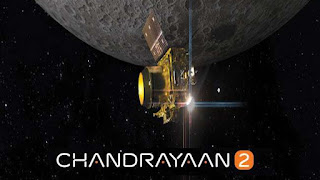Chandrayaan-2
What, Why & How?
- It is India's second lunar mission.
- It is launched with India's most powerful rocket GSLV MK-III from Satish Dhawan Space Centre in Sriharikota in Andhra Pradesh.
- The mission is to collect scientific information
- Regarding the moon's topography, mineralogy,
- Elemental abundance, lunar exosphere and signatures of hydroxyl and water-ice.
- It has 3 modules (detachable units) namely
- Orbiter, Lander (Vikram) and Rover (Pragyan).
- The orbiter and lander are an integrated module and will be accommodated inside GSLV
- MKIII. The rover (Pragyan) is enclosed inside the lander (Vikram) Once GSLV MK III launches the spacecraft into the earthbound orbit, the Orbiter propulsion module will kick-off and takes the integrated module to the moon orbit.
- Then, the Vikram lander would separate from the Orbiter and will make a soft landing at a predetermined area near the lunar south pole. After that, the wheeled Pragyan rover would roll out from the lander for carrying out scientific experiments.
- The data collected by the modules would be relayed back to earth.
What are the significances of the Chandrayaan-2 mission?
Indigenous: All three modules - orbiter, lander,
and rover are developed by India.
Landing mission: Unlike Chandrayaan-1 (India's 1st lunar mission) which involved only orbiting of the moon, Chandrayaan-2 would attempt a soft
landing on a site close to the south pole of the
moon.
Global power:
If successful, India will be the 4th country after
the USA, Russia, and China to land a rover on the moon India will be the 1st country to land on the
southern pole of the moon.
This would give the opportunity to ISRO for
naming the site on the moon where the mission
landed.
South pole landing:
All the earlier landings by various space
agencies have been in the areas close the moon's
equator because the equator receives more
sunlight which is needed for solar-powered
instruments aboard.
However, ISRO decided to land the modules on
the south pole due to its enormous significance
as follows
The south pole may contain clues to the
fossil records of early Solar System.
It also holds the possibility of the presence of water
Furthermore, this area is supposed to have
ancient rocks and craters that can provide
indications of the history of the moon.
Future space explorations: Moon is the perfect test-bed for experimenting technologies required
for future space missions India's footprint in the
space sector will be expanded.
The mystery of the universe: it will push
the boundaries of scientific knowledge to unravel the mysteries of this universe. It will make India a key contributor of exploring and uncovering
secrets of the universe, thus fostering shared
aspirations of the international community.
R&D: It will unleash innovation by throwing
challenges at the youth of the country, and
spurring future research and development.
Economy: It will strengthen ISRO's alliance with the industry thus boosting economic growth as well as the growth of the space sector.
What are the challenges
involved?
Trajectory accuracy: Ensuring accuracy of
trajectory while navigating 3.844 lakh km has its own challenges.
Orbit: The uneven lunar gravity may affect the
orbit of the spacecraft.
Extreme temperatures: A lunar day or night
lasts 14 earth days, resulting in extreme surface temperature.
Soft-landing: Once the Lander and Rover enter
the Moon's gravity, they would be in a state of free
fall. That could end up in crash-landing and
destruction of the instrument. These instruments cannot make use of parachute-like technologies due to lack of air in the moon to provide drag. Therefore in order to enable a smooth landing, the speed of the Lander just ahead of touchdown should be 6 kilometers per hour or less which is a major challenge. Lunar dust: Firing engines close to the moon's surface will lead to the backward flow of gases and dust, causing hindrance to deployment mechanism and damaging sensors.
Communication challenges: Due to the large distance from Earth, radio signals, which need to be picked up, would be weak.












No comments:
Post a Comment